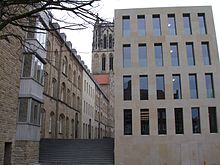Diocesan Library of Münster
| Diocesan Library of Münster | |
|---|---|
|
Liudgerhaus (left), diocesan library (right), Überwasserkirche (background)
|
|
| place | Muenster |
| ISIL | DE-Mue73 |
The diocesan library on Überwasserkirchplatz at the Überwasserkirche in Münster in Westphalia is the central library of the Münster diocese . According to its own information, it is one of the largest special theological libraries in Germany, with around 750,000 volumes and 720 periodicals . There are also several thousand historical manuscripts.
history
The history of the library and thus also of the collection goes back to the year 1401, when the fraternal lords or “brothers from living together” built their own house in the Westphalian city. Since then, the size of the collection has increased steadily, even in spite of the interruption in 1535 and 1536, when the Anabaptists ruled in Munster and a non-quantifiable part of the collection was lost.
In 1772 the religious order was dissolved and the collection merged with that of the Critinianum. From 1776 onwards, they were to represent the basis of the library of the newly founded seminary. With the secularization at the beginning of the 19th century, the stock increased by leaps and bounds when the stocks of the dissolved monasteries were integrated.
In 1958, the library got back the management of the internationally known Santini collection , which it had acquired in 1855 and placed under the care of the Westphalian Wilhelms University for 25 years in 1923 . It was not until 1960 that the library was opened to the public. In 1977 it was separated from the seminary as an independent diocesan library and one year later it was moved to its own building in the immediate vicinity of the Überwasserkirche. The library was expanded again in January 1995 with the addition of the Franciscan Study and Central Library. It is on permanent loan to the diocesan library. In 2003 the old library building was demolished and replaced by a larger new building designed by Max Dudler , which was opened on December 9, 2005 and consecrated and blessed by Bishop Reinhard Lettmann .
Special collections
The holdings of the diocesan library in Münster include several special collections. The most important and best-known is the Santini collection of the Italian priest, composer and music collector Fortunato Santini (1778–1861). This collection, which has been in the possession of the diocese of Münster since 1855 and was moved from Rome to Münster in 1862 , is considered to be one of the most extensive and valuable sources of Italian music. It contains around 20,000 titles in the form of around 4,500 manuscripts and 1,200 prints from the 16th to 19th centuries.
Another important collection is the library of the brotherhoods. This is an extensive, closed collection. It is of particular importance, as the brotherhoods had a significant influence on writing and letterpress printing in the early modern period . This collection consists of twelve manuscripts, around 120 cradle prints and 300 early prints, as well as around 1,400 volumes. They were all created between 1531 and 1770.
Other special collections are the library of the Critinianum and the prayer and hymn book collection of the former Ludgerianum . The latter is an important and extensive collection for the history of piety in north-west Germany. In addition, various holdings from former parish and monastery churches of the diocese and from the former diocesan museum as well as the library and the collection of letters from Peter Wust of the diocesan library of Münster belong .
Web links
Individual evidence
Coordinates: 51 ° 57 ′ 53 ″ N , 7 ° 37 ′ 19.5 ″ E


